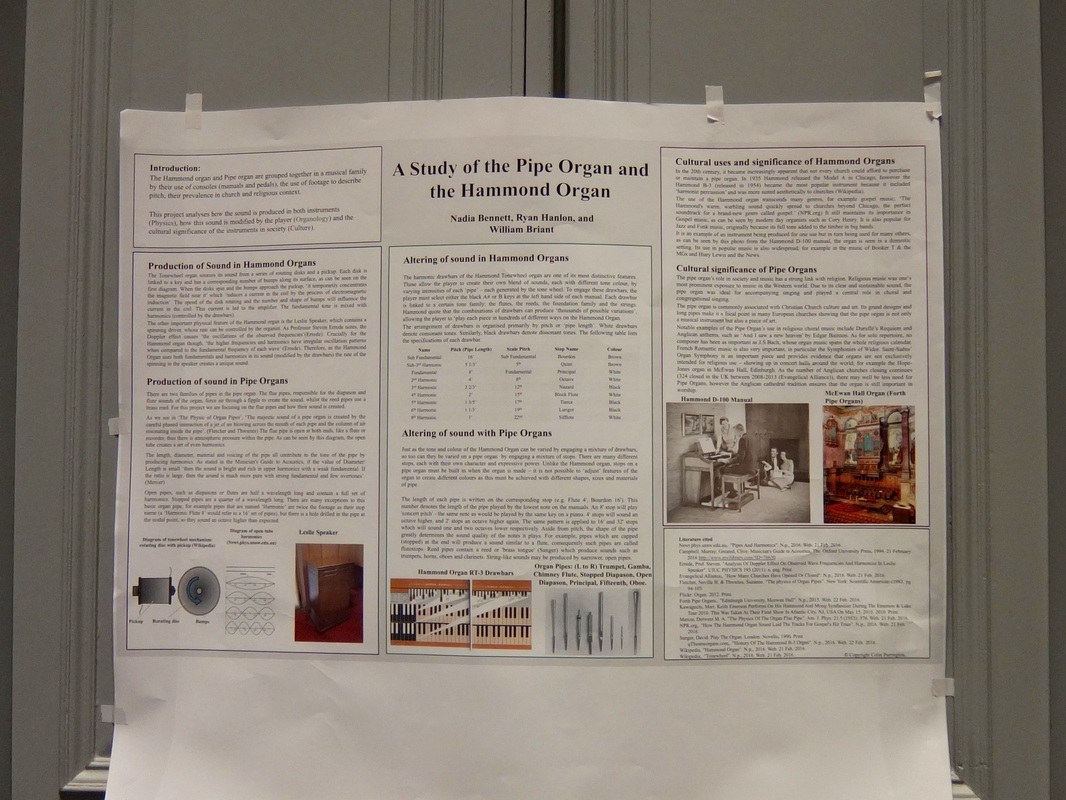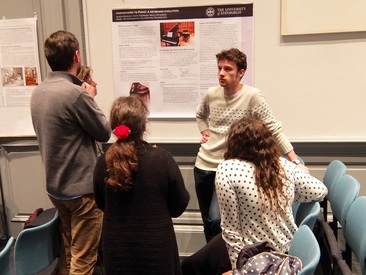|
I spent yesterday evening at the Edinburgh College of Art, observing students from Edinburgh University’s MA (Hons) Music, as they participated in a poster assessment exercise. The invitation followed a recent interview-over-coffee with Dr Tom Wagner where he generously spent an hour talking enthusiastically about the innovative and evolving nature of assessment on the Music programme. The MA (Hons) Music was originally of interest to me as it’s a degree programme that is simultaneously situated in both the Humanities and what we might describe as the ‘creative disciplines’. The short video on this page neatly describes the distinct nature of the programme. The poster presentation assessment exercise challenged students to work together as they sought to investigate and then present the technical, historical and cultural significance of an instrument on their choice. I now have a greater appreciation of the accordion, hammond organ and Les Paul guitar, although no greater talent for putting any of these fine instruments to good use. The exercise is worth a 40% of the final mark for this particular course so its clear that this falls into the category of high stakes assessment. In an e-mail conversation earlier in the day Tom had revealed a mixture of enthusiasm and anxiety for this first-outing-as-an-assessment exercise and he repeated the “Fingers crossed it works!” mantra when we spoke at the beginning of the evening. My interest was in studying the different ways that students used the poster (and to a lesser extent its presentation) as a way of constructing and conveying meaning. At the same time I was keen to learn how they felt about the experience of putting together a multimodal artefact that drew on a range of resources, including and beyond language. With Tom’s permission I observed and spoke to students before, during and after the presentation of their work. I also took photographs of the posters and the wider class activity (again with permission of staff and the students concerned). Every poster featured a combination of words and images, most commonly pictures of instruments but also what I understood to feature soundwaves and other technical information. Other visual elements included an attention to the use of colour, background and typeface. The posters varied in the extent to which they moved away from what we might think of as the ‘essayistic’ conventions of linearity and a privileging of language. In every instance, printed text featured heavily and there was often a suggested path for me to follow through the poster (and on one occasion a series of arrows in order that I didn’t lose my way). This reminds of research by Lea and Jones (2011) into the practices of students at three UK universities where they found a reluctance to stray far from conventional ways of sharing knowledge. It also echoed the study by McKenna and McAvinia (2011) which pointed to a persistent attachment to linearity amongst students, even when presented we new, digital, creative ways of conveying meaning. This is simply an observation of the posters, not a criticism: indeed, the different groups may have felt that the most effective way of conveying their ideas was to transpose conventional language-based approaches onto the PowerPoint canvas. There were however examples of work where clearer acts of design were on show, for instance where motifs framed the page, or where text was laid over an image of a performing musician. On other occasions the poster itself was placed in juxtaposition with a separate object: a book of organ music sitting on a chair; a selection of trombones laid out parallel to the poster; a laptop with a looping video, which had seen Michael “basically spending about an hour and a half looking for examples of different type of accordion music” in order to show to tutors the variety of ways that the instrument was used. This final example is interesting in that of all the posters I studied, this was the only where the presentation would be accompanied by music. This makes me think of Gunther Kress’s work around aptness of mode (2005) where he proposes that multimodality enables us to consider the particular range of resources that might best convey intended meaning: a poster presentation about the accordion, featuring an accompanying accordion soundtrack, would be seem to be a very effective enactment of this principle. The presentation of the posters meanwhile made use of spoken language, voice, eye contact, gesture and other modes. Perhaps reflecting the high-stakes and unfamiliar nature of the exercise, most students were fairly rigid as they presented their work and arguments to tutors. An alternative explanation is that the layout of the lecture theatre rarely left much room to make use of expressive gesture to support the presentation of ideas. When they weren’t setting up or presenting their posters, many students took the opportunity to look at the work put together by other groups. Unprompted, clusters formed where students gathered to put questions to the authors of the different work. Reflecting on this, Peter described to me how he had “learned lots of new things about different instruments tonight” while a number of students remarked on how impressed they had been with the level of work displayed around the room. “Everything looks really good” Charlotte remarked, while Maria added “Loads of work has gone into this”. There was something really nice about the willingness of students to look beyond their own work: there was a sense of collaborative learning as students constructed a broader knowledge and understanding of their subject from the range of posters and approaches around the room. I was also interested to hear whether the students had any prior experience of putting poster presentations together. Although Karen described “doing this kind of thing in high school”, for the most part the poster exercise was a new approach for almost every member of the class. The exceptions were two self-described ‘visiting students’, who told me that this type of approach had been a feature in their studies in the US. In particular, Carl described his academic background in technical engineering where it was commonplace to use posters as a way of helping to explain potentially complex ideas to an audience. I was also interested to learn how students had found the wider experience of the exercise. Claire’s immediate response, delivered through a mixture of relief and laughter was that “I'm just glad it's not an essay!” which was met with the approval from the rest of her group. This was a feeling that would surface repeatedly in discussion, although two students pointed out that while it worked well in this type of assignment task, “an essay would be better suited on other occasions” (Mark). When pushed on this, Sarah explained “Well, I liked working on the poster as part of a group, but all the decisions you have to make - I’m not sure I would feel so confident doing it on my own”. When asked whether they would like to take this approach in the future, many students were enthusiastic about the poster approach however others suggested that the essay continued to be attractive as it didn't force them to make so many decisions about the form of their work. It was very clear that students had really enjoyed the exercise, and this was the position taken even by those who were nervously awaiting their turn to present the poster to their tutors. It is difficult however to unpick how their enthusiasm for the assignment was attributable to the form of the exercise (presented as a poster), the subject matter (selecting and studying an subject of interest to them) or whether it was the opportunity to work collaboratively. What come through very loudly amongst several groups was how they had enjoyed learning from the drawing on the different interests and talents of fellow group members. This was a point neatly captured by Jimmy who told me “I have an interest in playing guitar, Nico is interested in the technical side and Annie knows about the social side”. Without setting out to critique this exercise, perhaps one of the benefits that it brings (against the preparation of an essay, which one groups told me had been the original intended format for the assignment) is that the presentation element enabled students to describe the critical decisions that had shaped their approach. Tutors were offered insights into the methodology behind the poster they were examining, potentially offering a clearer appreciation of the learning that had taken place. This attention to the process behind the work, as well as the final artefact itself, features prominently in the research literature surrounding multimodality and assessment (for instance in the studies by Breeze (2011), Pandya (2012) and Wyatt-Smith Kimber (2009)) whilst the type of reflection being encouraged and shared by students would seem to echo the how multimodal artefacts can be valuably accompanied by the completion of a reflective essay (see for example by Adsanatham (2012), Barton and Ryan (2014) and Coleman, (2012). Drawing my thought here to a close, what I saw last night was an assessment exercise that had clearly excited students, whilst at the same time challenging them to construct and convey their ideas in new ways. Rather than working in ‘isolation’ on an essay (a situation a number of the students attested to), they had been challenged to work and learn collaboratively. At the same they had been forced out of their comfort zone of music composition and performance, and beyond the familiarity of the written form, to demonstrate understanding through an orchestration of semiotic resources, which required them to undertake acts of design. If student engagement is a vital measure of learning, in an environment driven by outcomes, benchmarking and performativity, importance is also placed on quantifying student progress and understanding. Or to put it another way, the success of this approach will also be measured by asking ‘How did the students do?’ Maybe if I promise Tom another coffee he’ll tell me how he and his colleagues felt about the quality of the poster presentations I enjoyed watching yesterday evening. With thanks to Dr Tom Wagner for his kind invitation to attend and to the students who took time to speak to me and allowed me to photograph their work. I have use pseudonyms in place of the real names of students cited above. References
ADSANATHAM, C. 2012. Integrating Assessment and Instruction: Using Student-Generated Grading Criteria to Evaluate Multimodal Digital Projects. Computers and Composition, 29, 152-174. BARTON, G. & RYAN, M. 2013. Multimodal approaches to reflective teaching and assessment in higher education. Higher Education Research & Development, 33, 409-424. BREEZE, N. 2011. Multimodality: an illuminating approach to unravelling the complexities of composing with ICT? Music Education Research, 13, 389-405. COLEMAN, L. 2012. Incorporating the notion of recontextualisation in academic literacies research: the case of a South African vocational web design and development course. Higher Education Research & Development, 31, 325-338. KRESS, G. 2005. Gains and losses: New forms of texts, knowledge, and learning. Computers and Composition, 22, 5-22. LEA, M. R. & JONES, S. 2011. Digital literacies in higher education: exploring textual and technological practice. Studies in Higher Education, 36, 377-393. McKENNA, C & McAVINIA, C. 2011. Difference and disconuity - making meaning through hypertexts. In Digital Difference: Perspectives on Online Learning. Land, R. and Bayne, S. (Eds) (Rotterdam, Sense Publishers): pp 45-60. PANDYA, J. Z. 2012. Upacking Pandora's Box: Issues in the assessment of English in Learners' Literacy Skills Development in Multimodal Classroom. Journal of Adolescent & Adult Literacy, 56, 181-185. WYATT-SMITH, C. & KIMBER, K. 2009. Working multimodality: Challenges for assessment. English Teaching: Practice and Critique, 8, 70-90.
0 Comments
Leave a Reply. |
Search categories
All
I am a Lecturer in Digital Education (Education Futures), within the Centre for Research in Digital Education at The University of Edinburgh.
@james858499 [email protected] |












